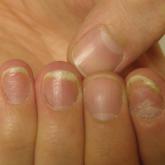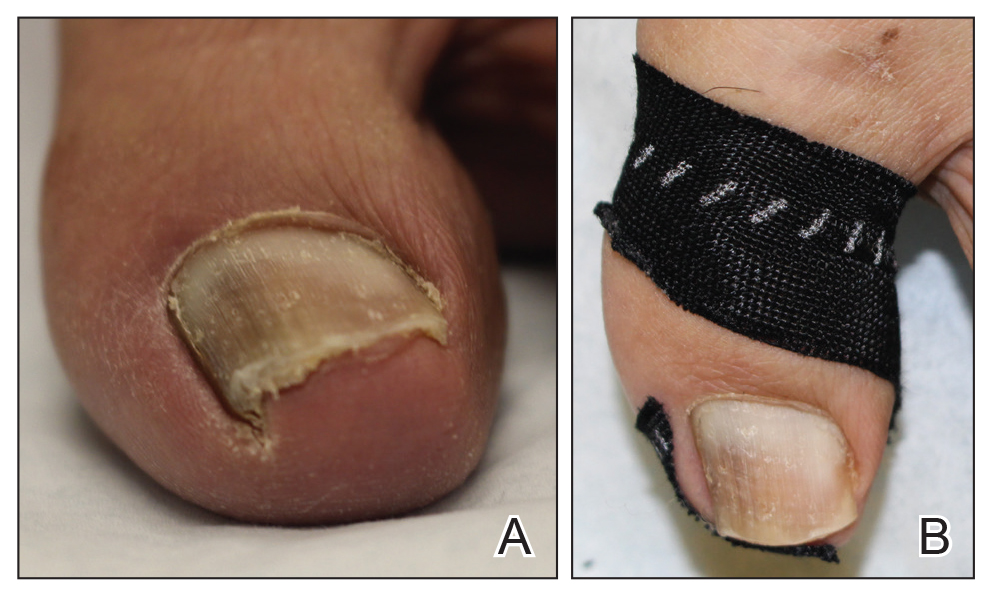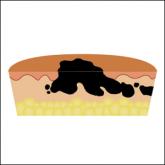Practical Pearls

Nail Psoriasis Tips
Patients commonly believe nail psoriasis is synonymous with fungal infection; therefore, proper counseling and accurate diagnosis is required...
Mr. Geizhals is from SUNY Downstate Medical School, Brooklyn, New York. Dr. Lipner is from the Department of Dermatology, Weill Cornell Medicine, New York, New York.
The authors report no conflict of interest.
Correspondence: Shari R. Lipner, MD, PhD, 1305 York Ave, New York, NY 10021 (shl9032@med.cornell.edu).

Onychocryptosis, or ingrown toenail, is characterized by penetration of the periungual skin by the nail plate. One conservative treatment is taping, but frequent detachment is a notable shortcoming. We describe use of kinesiology tape to overcome this limitation for effective treatment of onychocryptosis.
Onychocryptosis, or ingrown toenail, is a highly prevalent nail condition characterized by penetration of the periungual skin by the nail plate (Figure, A). Patients may report pain either while at rest or walking, which may be debilitating in severe cases and may adversely affect daily living. Treatment may be approached using conservative or surgical therapies. Conservative methods are noninvasive and appropriate for mild cases but require excellent compliance. Although nail trimming is the simplest method, it may necessitate cutting soft tissue, particularly when the nail is anchored deep within the periungual skin. Another conservative method is taping, which aims to separate the nail fold from the offending nail edge by using an adhesive. In common practice, the adhesive often detaches within a few hours, which is further exacerbated by moisture from sweating or bathing.1 Therefore, for effective treatment of onychocryptosis, the tape typically must be reapplied multiple times per day, limiting compliance.

A, Onychocryptosis of the left first toenail. The lateral aspect of the nail plate is penetrating the periungual skin of the lateral nail fold. B, Kinesiology tape was placed on the medial aspect of the lateral nail fold and pulled in an oblique and proximal direction around the toe dorsally, separating the nail fold from the intruding nail plate.
We propose using kinesiology tape to treat onychocryptosis. Kinesiology tape is a highly elastic adhesive that was originally employed by athletes to relieve pain while supporting muscles, tendons, and ligaments during strenuous activity. We hypothesized that its stronger adherent properties and greater elasticity would be advantageous for treatment of onychocryptosis compared to standard tape.
A strip of tape is cut to approximately 10 to 15 mm×5 cm and is applied once daily to the lateral nail fold, pulling it away from the nail plate in oblique and proximal directions and then wrapping it around the plantar surface dorsally (Figure, B). Kinesiology tape properties allow for less frequent application and greater tension to be applied to the nail fold while reducing the risk for vasoconstriction, as the tape does not need to be fully wrapped around the digit for reliable adherence.
Kinesiology tape adheres more firmly than other tapes and requires less frequent applications. Use of kinesiology tape for onychocryptosis therapy often is effective and may negate the need for more invasive procedures and improve quality of life during and after treatment.

Patients commonly believe nail psoriasis is synonymous with fungal infection; therefore, proper counseling and accurate diagnosis is required...
Dermatologic surgery commonly involves wound closure. The goal is to find the repair option that best fits the patient's expectations and...

Mohs micrographic surgery (MMS) is a challenging procedure to conceptualize, yet it is an integral component of dermatology residency. The...
